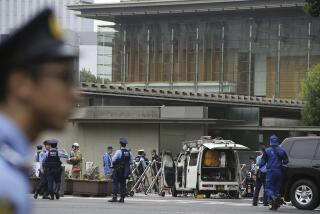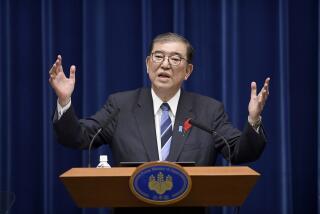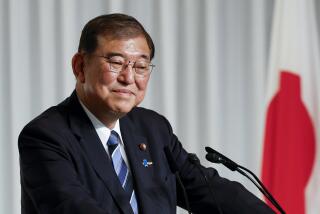Japan Premier Gives Top Post to Takeshita
TOKYO â Japanâs Prime Minister Yasuhiro Nakasone today named Noboru Takeshita, 63, a traditional consensus-builder, to succeed him.
Three candidates entrusted Nakasone with the decision after a round of talks stretching over more than 12 hours failed to produce agreement on who should be the new president of the ruling Liberal Democratic Party. Under Japanâs parliamentary-style government, the leader of the party with the majority of seats in Parliament also becomes prime minister.
Nakasone responded by choosing Takeshita (pronounced Tah-kay-shâtah), who commands the largest faction of followers within the party that has ruled Japan since 1955.
Takeshita, who is now the partyâs secretary general, had served Nakasone as finance minister for three years and eight months. He said his reaction was one of âtension.â
âI feel that a great burden has been placed upon my back,â he said. âIts weight is pressing down upon my shoulders. . . . I feel I must devote my life to the nation, to the people and to world peace.â
Nakasone, announcing his decision after midnight through the partyâs deputy secretary general, gave no reasons for his choice. But it was obvious that the 69-year-old premier, whose term ends Oct. 30, aligned himself with the results of 12 days of talks among the three candidates for the partyâs top post.
In an eight-hour meeting with Takeshita on Monday, Shintaro Abe, 63, the partyâs executive board chairman, refused to bow out of the race but declared that he would remain âalliedâ with Takeshita against Finance Minister Kiichi Miyazawa, 68, the third candidate. The combination gave the two a commanding edge over Miyazawa and offered the greatest prospect for party stability.
Miyazawa was excluded from the marathon Takeshita-Abe meeting, although earlier he had participated in six rounds of talks with his two rivals in an attempt to avert a vote among the partyâs 445 members of Parliament that had been scheduled for today.
The three aspirants met for a seventh time shortly before 10 a.m. Monday and agreed to ask Nakasone to make the choice among them âwithout conditions.â They also handed over letters declaring that they were dropping out of the party presidentâs race and promised to abide by Nakasoneâs decision and uphold party unity.
Two Letters Accepted
After Nakasone made his decision, only Takeshitaâs letter was returned, while the other two were accepted.
Without naming his preferences, Nakasone recommended that the losers be appointed to posts as deputy prime minister and secretary general of the ruling party. Miyazawa was expected to be named deputy premier, while Abe was reported to be in line for the party job.
The Liberal Democratic Party will hold a convention Oct. 31 to formalize Nakasoneâs appointment of Takeshita as party president for a two-year term. It will then convene a special session of Parliament, probably around Nov. 6, to vote him into office as prime minister.
Takeshita earlier had pledged to continue Nakasoneâs policies, including the prime ministerâs program to transform Japanâs economy from one driven by exports into one reliant upon economic growth at home. Like his rivals, Takeshita is committed to Japanâs alliance with the United States but, over the years, has displayed no interest in or knowledge of defense issues.
Noted as Fund Raiser
The son of a sake (rice wine) brewer who became an unlicensed English teacher in a Shimane prefecture junior high school before entering politics, Takeshita developed his chief expertise in political tactics as a lieutenant in factions headed by the late Prime Minister Eisaku Sato and by former Prime Minister Kakeui Tanaka. He is noted for his ability to raise political funds rather than to make policy.
Takeshita has likened the role of prime minister to that of a âmaster of ceremoniesâ presiding over traditional consensus-making discussions. By contrast, Nakasone said he preferred a presidential-style of leadership as prime minister.
Unlike both of his rivals, who were graduated from the prestigious state-run Tokyo University, Takeshita obtained a business degree from Waseda University, a private school.
He has promoted only one policy idea--more a slogan than a policy--of making all of the Japanese archipelago âa hometownâ by spreading urban-like conveniences and access to cultural activities and job opportunities throughout the country.
Takeshitaâs experience in diplomacy came in serving twice as finance minister--from November, 1979 to July, 1980, and from November, 1982, in Nakasoneâs first Cabinet, until July, 1986. He represented Japan at the Group of Five meeting in New York in September, 1985, at which the finance chiefs of the worldâs five leading industrial nations approved a policy of driving down the value of the dollar.
Political analysts view him as the antithesis of Nakasone, an outspoken, aggressive leader who launched a series of reforms in government administration, education, budgeting, taxes, and even of Japanâs economic structure itself.
Miyazawa, the favorite of both business leaders and bureaucrats, was widely regarded as Nakasoneâs personal preference. Although the most brilliant of the three contenders and a master of policy-making, Miyazawa heads a faction of ruling party members of Parliament with only 89 followers, compared with the 113 members of the old Tanaka faction that Takeshita embraced in setting up his own organization in July.
Takeshitaâs alliance with Abe, who commands 86 followers, moreover, was bolstered by Toshio Komoto, 76, a former Cabinet member and deputy prime minister, who leads a faction of 31 members. Although the tripartite alliance failed to agree upon a single candidate, its total force represented 231 votes, or a majority of eight, if a vote of the partyâs Parliament members had been held.
All three candidates agreed that an election, which in the âharmony cultureâ of Japan threatened to create a divisive, emotional aftermath within the ruling party, should be avoided.
After learning of Nakasoneâs choice, both Abe and Miyazawa pledged to cooperate âto the ultimate degreeâ with Takeshita.
More to Read
Sign up for Essential California
The most important California stories and recommendations in your inbox every morning.
You may occasionally receive promotional content from the Los Angeles Times.










